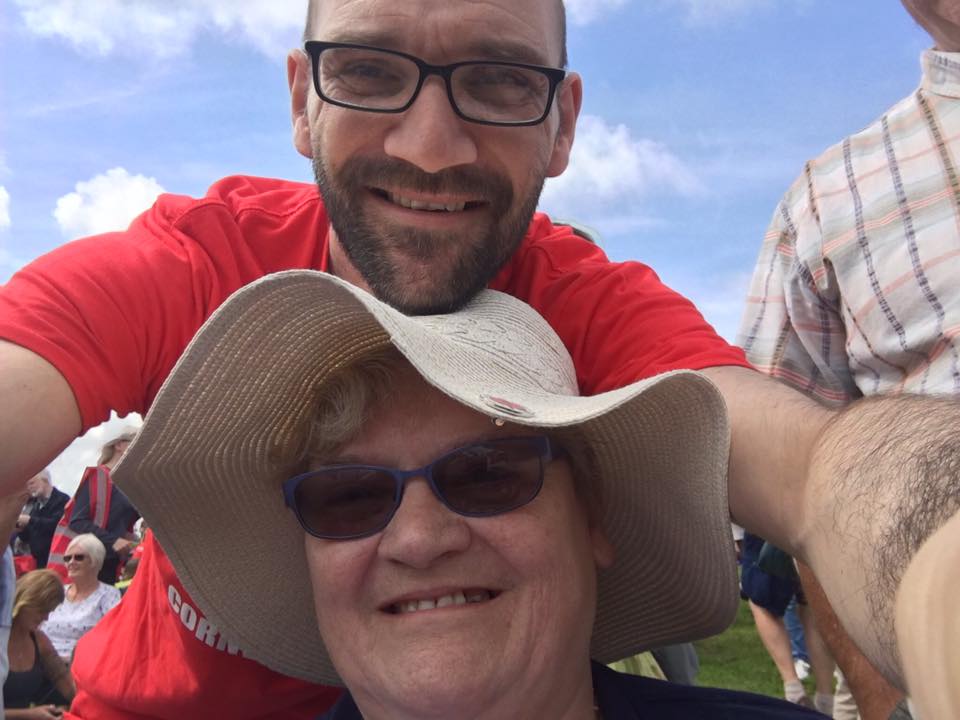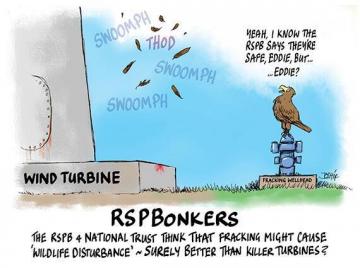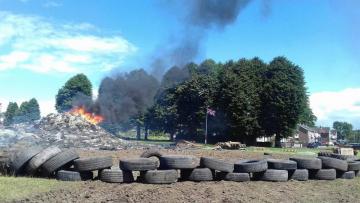SURVIVORS OF THE BOMB: THE HIBAKUSHA
LONDON. OCTOBER 2016
From James Florey
As most of the doctors were killed in the atomic blast a horse vet had to scoop out the burnt and useless right eye of Mariko Higashino’s grandmother. There was no anaesthetic or antiseptic for the terribly injured 42-year-old woman. Amongst Hiroshima’s ashes & corpses Makiro’s then 17-year-old mother listened to the screams of her mum and thought they were in living hell. She knew at that point, on that August morning in 1945, that all war must be abolished and people must never go to war again.
Mariko is a 2nd generation Hiroshima survivor (or ‘Hibakusha’). Born in 1952 – the same year that the UK detonated its first nuclear bomb – she luckily escaped the radioactive poison inherited by so many of the children of Hiroshima’s survivors. Her mother and grandmother were both in the city the morning the atomic bomb was dropped from the specially silver-metal-plated US Army Airforce B29 bomber. Both survived. Mariko’s mother only opened up about her experiences three years ago. Mariko has now been officially certified by her government to pass on the story, which she does around the world.
The Hibakusha
Hibakusha is the name given to the survivors of the 1945 nuclear bombings. It literally translates to ‘explosion effected people’. Two categories of Hibakusha are recognised by Japanese authorities, those who were in or around the hypo-centre of the blasts, or those who were born to the survivors. Today over 160 of the 170,000 Hibakusha have dedicated themselves to an on-going global peace mission. The ‘Peace Boat Hibakusha Project’ travels around the world, its special passengers calling for the abolishment of nuclear weapons and power. This week (October 3rd & 4th) saw the Hibakusha peace boat docking in London. Five of the Hibakusha began their mission to share their testimonies of survival and death and build momentum to ban nuclear weapons.
At the Quakers Friends Meeting House, in central London on Monday 3rd October a few of the Hibakusha gave their testimonies of painful survival and violent death in front of a small audience. No press or media seemed to be there, no glaring cameras, snapping photographers, pushy reporters, or sniffing newshounds. The event seemed to have gone under their radar. At the same time that the Hibakusha told of their horrors it seemed the mass media were composing and publishing endless streams of near-hysterical new nuclear arms race stories, warning of the threat of nuclear war, of good vs evil in the guise of the west vs the east, the USA v Russia. Like a sport, or a film.
2 / 5
Hiroshima attack
Mariko told her mother’s story, a story of death, suffering and survival in the city of Hiroshima on 6 August 1945. The bomber, Enola Gay, piloted by Colonel Paul Tibbets, dropped its atomic bomb at 8:15am. The air burst detonated 580 metres above the city. The blast was the equivalent of 16 kilotons of TNT, the blast area covered a mile.
Mariko continues the story, “My mother was only 17 but had been mobilised as part of the war effort. She was working as a nurse in Funairi hospital 1.8km from the hypocentre. Her and two of her friends had been given the day off. They planned to go swimming and to meet at 8:15 in the morning. At 8:10 she realised she was running late. She yelled to her mother, ‘I’m off’, took a look in the mirror by the front door and suddenly saw a huge flash then a huge BANG! She was knocked unconscious and blown 30 metres into a nearby sweet potato field.
As she woke up she saw a huge billowing cloud. Then it began to rain, black raindrops – this was the radioactive fallout. My mother looked down the street and she saw melting people coming towards her. They were calling for water saying, ‘it hurts!’ Their calls grew fainter and in groups of about 20 or 30 they lay down and died. For those not killed in the blast and vacuum but caught in the black rain it took them three days of washing to get the rain off of them. My mother was a nurse so she instinctively tried to take care of injured people. But she had no help so went into the city centre to look for doctors and nurses. The city was completely destroyed and turned to ash and cinders. She came to the river which was just packed full of the red bodies of people. She looked for help in vein. There was no life in the city. Eventually she found her mother who had been caught in the blast but was alive. The bomb had exploded on the right of her mother. She was completely burnt black down her right side and her right eye was bleeding severely. The nurses and doctors had almost all been killed and they died – like many others – bleeding from their mouths. A horse vet was the only medically trained person my mother could find to treat my grandmother. He decided her eye must be removed and he had to do it with no aesthetic and no antiseptic. As he scooped her eye out with her horrific screams in the air, my mother thought that they were all in a living hell – she knew there and then that all war must be abolished and humans should never again go to war with each other.”
70 – 80,000 men, women, children, soldiers, Korean slaves, & Allied POWs had been killed instantly. Another 70,000 were injured by the blast and radioactive fall-out and would die painfully some time afterwards. Three days later US President Harry Truman ordered another nuclear bomb attack on another Japanese city.
3 / 5
The Nagasaki bomb
A brown faded old photograph of four cheerful looking children survived the Nagasaki blast, flash and fall out from the plutonium bomb.
Three out of four of the children pictured had been killed. Johji, then 14, today 85 years old, survived to bear witness of nuclear holocaust. Both he, and the photograph were some distance away from the hypo-core of the bomb blast, dropped on the city of Nagasaki on 9 August 1945. The weapon named ‘Fat Man’ was carried by a US Army Airforce B29 bomber Bockscar. The flight commander, Major Sweeny, had originally been ordered to target the city of Kokura but his aircraft was running low on fuel so at 11.01am the secondary target of Nagasaki was attacked instead.
“My mother, my two brothers and sister were all killed.” Johji remembered. “Everybody who was 1000 metres within the hypo-centre were killed instantly. People who were 3000 metres away took a week or longer to die from the radiation fall-out – including my 12-year-old brother Kouji.” As a teenage factory conscript in Nagasaki Johji was working at the Mitshubishi munitions factory located 3.3 kilometres from the centre of the blast. The factory wasn’t put out of action and Johji was uninjured. “I remember seeing a huge cloud, and feeling tremendous heat. In the hypo-core temperatures were as hot as the sun.” Many victims caught in the blast quite literally left only their shadows burnt on pavements, walls or steps behind.
Johji continued, “The blast blew buildings and people to pieces but there was also a terrific vacuum which sucked up bodies and bits of debris and created a huge cloud.”
Johji ventured into the city and towards the hypo-core looking for his family. “My house was located 600 metres from the hypo core. My brothers and sister were all killed. Akio was 10, Machiko was 5, Kouji was 12. When I went back to the city centre at the hyper-core was there was nothing left but ash. I looked around for my house and for my family. I found my brothers’ bodies in different parts of the city. The blast and the vacuum had thrown bodies all around.”
At the same time that the USA, with the backing of the UK, were bombing hundreds of thousands of Japanese civilians to death, The USSR attacked the Japanese army in Manchuria. The Japanese government quickly surrendered on the condition they keep their emperor, Hirohitho. Much has been argued about the conventional and nuclear bombing of Japanese civilians. It’s worth considering however that one conventional bombing raid by the US Army Air Force in March 1945 killed between 100,000 to 200,000 people – greater than the deaths of the nuclear attacks. Yet when faced with a battle against the Red Army that August the Japanese promptly surrendered.
Crucially then were the two nuclear bomb attacks a mere political message from President Truman to the USSR?
4 / 5
Nuclear arms race
The decades after the end of the Second World War were the years of a nuclear arms race and the Cold War. The USA, USSR, the UK, France, China, Israel, India, others all armed themselves to the teeth with countless nuclear war heads. None have been used.
In 2016 The International Campaign to Abolish Nuclear Weapons (ICAN) cites, ‘Nine countries together possess more than 15,000 nuclear weapons. (with 93% of the arsenal) The United States and Russia maintain roughly, 1,800 of their weapons on high-alert status – ready to be launched within minutes of a warning.’
The five Hibakusha visiting London this week all give testimonies to what these weapons can and have done to them personally. Noriko Sakashita was a two year old little girl in Hiroshima. Her house was 1.4km away from the hypo-centre. She was blown several metres away by the blast. She was injured by glass, and debris cutting her little head. Nokiro suffered from radiation sickness afterwards as she was caught by the black rain. Takaaki Morikawa was in hospital 10km from the Hiroshima hypo-centre. He was just six when he was exposed to black rain, and ingested contaminated food. Toshiko Fukahori survived the Nagasaki attack aged 10. Her home was 2.7kilometres from the blast centre. Toyoko Tagawa endured the same atomic attack 9.2kilometres away. Her brother, a medical student, was only 500 metres away from the hypocentre and took 10 days to die in great pain in front of his family.
5 / 5
Abolish nuclear weapons immediately!
Members of the UK parliament, urged by the new Conservative Prime Minister, recently voted to renew and update the British nuclear weapon system, Trident. Some voted against this, including members of the SNP, the Labour leader Jeremy Corbyn and his defence spokesman Clive Lewis who revealed that he is working towards a global outcome of abolishing nuclear weapons.
Next year, in 2017 it has been announced that a special United Nations General Assembly conference in Geneva will convene to negotiate the legal prohibition of all nuclear weapons leading towards their total elimination.
Meanwhile UK Prime Minister Teresa May with one firm word told the world, ‘yes!’ she would be prepared to unleash nuclear weapons that would kill and maim hundreds of thousands of people.
The Hibakusha response to this is simple, “We survivors say that what we experienced should never happen to another person ever. What we went through we do not want anyone else to endure.”
“It’s impossible for anyone to understand the effects and harm of a nuclear bomb unless you have survived an attack. The sights, the sounds, and the awful smells are hellish. The misuse of the atom should be stopped immediately – in war weapons and for energy use. I urge everyone alive who can
to work towards this. I call on the UK to abolish their nuclear weapons immediately and never go to war again!”
(THIS ARTICLE WAS ORIGINALLY WRITTEN FOR THE VETERANS FOR PEACE UK WEBSITE OF WHICH JAMES IS AN ACTIVE LONDON BRANCH MEMBER)
Sources: –
9th Peace Boat Hibakusha Project
International Campaign to Abolish Nuclear Weapons
United Nations Office for Disarmament Affairs
‘The Second World War’ – AJP Taylor, London 1975
Personal testimonies by Mr Johji Fukahori, Toshiko Fukahori, Takaaki Morikawa, Toyoko Tagawa, Noriko Saksashita, Mariko Higashino
#UnityMarchUK
If you like our content please consider helping us to take back the media
https://www.gofundme.com/UnityMarchUK


